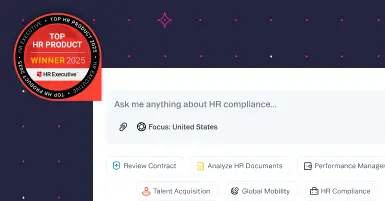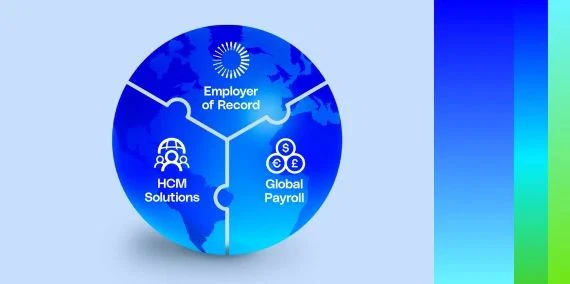G-P's Employer of Record (EOR) model allows your company to start hiring talent in minutes via our global entity infrastructure. Our professional AI-powered EOR solution in India streamlines the hiring process, helping businesses comply with Indian labor standards while expanding globally.
As a global EOR expert in India, we manage payroll, employment contracts, statutory and market norm benefits, employee expenses, as well as severance and termination to ensure compliance. You'll have peace of mind knowing you have a dedicated team of employment experts assisting with every hire and ensuring compliance with Indian regulations.
Hiring in India with an EOR
India is a rapidly developing country, offering exciting opportunities for global talent acquisition. When hiring employees in India , it's vital to understand the local business culture and employment expectations, which our AI-powered EOR services in India help facilitate. Remote work is increasingly popular, especially in major hubs like Bangalore, Mumbai, and Delhi, offering access to a wider talent pool and optimizing workforce strategies.
On average, employees in India anticipate an annual wage increase of around 9-10%. Meeting these market expectations is key to talent retention. SaaS EOR services in India can streamline hiring in the Indian market by providing specific salary insights. When negotiating an offer, it is essential to have a clear understanding of all local requirements, from contracts to benefits .
Employment contracts in India
India's labor law framework is a complex mix of central and state-level legislation. It is a legal best practice to have a strong, written employment contract for every employee, detailing their compensation, benefits, and termination requirements. In some states, a written contract is a statutory requirement. An offer letter and employment contract in India must always state the salary and any compensation amounts in Indian Rupees (INR). Partnering with an EOR in India ensures that all employment contracts are fully compliant with current regulations.
Working hours in India
Working hours in India are primarily governed by state-specific Shops and Establishment Acts. While specifics can vary, the standard is a maximum of 48 hours per week and 9 hours per day. Employees are generally entitled to one rest day per week. Any work performed beyond these hours is considered overtime and must be compensated at double the employee’s normal rate of wages.
Holidays in India
India observes 3 national public holidays:
-
Republic Day (January 26)
-
Independence Day (August 15)
-
Gandhi Jayanti (October 2)
Beyond these, each of India's 28 states and 8 union territories has its own list of public holidays based on regional festivals and customs. Employers must follow the holiday schedule applicable in the state where the employee is based. Utilizing an AI-powered EOR service provider simplifies the process and ensures compliance with local statutory and market norms.
Vacation days in India
The statutory minimum for paid annual leave (or privilege leave) is determined by state laws and typically ranges from 15 to 21 days per year after one year of service. To remain competitive, many companies offer between 18 and 25 days of paid vacation. Offering generous leave can be a key factor in attracting and retaining top talent.
India sick leave
Sick and casual leave entitlements are also governed by state-level legislation. A common market practice is to provide 12 days of combined sick and casual leave annually. While not statutorily required for all employees, providing clear sick leave policies is standard practice for competitive employers.
Maternity and paternity leave in India
Under the Maternity Benefit Act, eligible pregnant employees are entitled to 26 weeks of fully paid maternity leave. To be eligible, an employee must have worked for the employer for at least 80 days in the 12 months preceding the expected delivery date.
There is no statutory requirement for paternity leave in the private sector. However, many progressive companies offer a few days to a few weeks of paid paternity leave as a supplementary benefit.
Health insurance in India
For employees earning up to INR 21,000 per month in covered establishments, enrollment in the Employees’ State Insurance (ESI) scheme is mandatory. For all other employees, providing a Group Medical Cover (GMC) policy is a standard market practice and a highly expected benefit. An EOR like G-P can facilitate access to comprehensive and competitive group health insurance plans, which are often more valuable to employees than a simple allowance.
India supplementary benefits
To create a competitive benefits package, many employers in India also provide supplementary insurance such as Group Term Life Insurance (GTL) and Group Personal Accident (GPA) insurance. These benefits demonstrate a commitment to employee well-being and are valuable for talent retention.
Termination and severance in India
Probationary periods are common and typically last 3 months, extendable to a maximum of 6. Termination procedures are complex and depend on the employee's classification (workman vs. non-workman), tenure, and the applicable state laws. Termination must always be for a just cause.
Notice periods are usually 1 month for confirmed employees, though this can be longer by contract.
For employees classified as 'workmen' under the Industrial Disputes Act, 1947, redundancy may trigger severance pay equal to 15 days' salary for each year of service. Furthermore, employees with 5 or more years of continuous service are entitled to a gratuity payment upon leaving the company.
India payroll and compensation
Structuring a compensation package in India requires careful attention to detail. The total package is referred to as Cost to Company (CTC). Under the Code on Social Security, 2020, it is best practice to ensure that the basic salary comprises at least 50% of the total CTC to ensure correct calculation of social security contributions. The remaining portion can consist of various allowances, such as:
-
Basic Salary: Fully taxable base pay.
-
House Rent Allowance (HRA): Partially or fully tax-exempt under certain conditions.
-
Leave Travel Allowance (LTA): Tax-exempt for travel within India, subject to limits.
-
Special Allowance: A taxable component used to cover miscellaneous items.
-
Bonuses/Incentives: Performance-based and fully taxable.
Managing India payroll compliance, including the correct structuring of CTC and deductions, is a core function of a SaaS EOR service.
Navigating payroll compliance in India
The challenging landscape of India's payroll compliance , with specific legal and statutory obligations, can be challenging for international companies. Our AI-powered EOR services in India assist businesses in these complexities, managing payroll, tax compliance, and fund contributions. Our guidance ensures that payroll processes adhere to Indian laws, reducing compliance risks. Companies benefit from our expert oversight to ensure accurate and timely employee payments, aligning with statutory demands, labor laws, and global engagement strategies
Paying taxes and social security in India
Employers and employees in India must contribute to several social security schemes. The primary schemes are:
-
Employees' Provident Fund (EPF): A retirement savings scheme.
-
Employees' Pension Scheme (EPS): A pension scheme funded from the employer's EPF contribution.
-
Employees' Deposit Linked Insurance (EDLI) Scheme: A life insurance cover for employees.
The employee contributes 12% of their basic salary to the EPF. The employer also contributes 12%, which is split between the EPF and EPS (8.33% to EPS, subject to a wage ceiling, and the remainder to EPF). Additionally, the employer contributes 0.5% to EDLI and administrative charges, bringing their total contribution to approximately 13%.
Income tax regimes
As of FY 2023-24, India's new, simplified tax regime is the default option for taxpayers. Individuals can still opt to use the old regime, which allows for various deductions like HRA. The applicable tax slabs for Financial Year 2025-26 for individuals less than 60 years of age are as follows:
New Regime (Default) — Tax Slabs FY 2025-26
|
Annual Income Slab (INR) |
Tax Rate |
|---|---|
|
Up to 3,00,000 |
0% |
|
3,00,001 to 7,00,000 |
5% |
|
7,00,001 to 10,00,000 |
10% |
|
10,00,001 to 12,00,000 |
15% |
|
12,00,001 to 15,00,000 |
20% |
|
Above 15,00,000 |
30%* |
*Surcharges apply to high-income earners.
Old Regime — Tax Slabs FY 2025-26
|
Annual Income Slab (INR) |
Tax Rate |
|---|---|
|
Up to 2,50,000 |
0% |
|
2,50,001 to 5,00,000 |
5% |
|
5,00,001 to 10,00,000 |
20% |
|
Above 10,00,000 |
30%* |
*Surcharges apply to high-income earners.
Navigating these tax obligations and social security contributions is a key area where an EOR provides value, ensuring full compliance and accurate payroll processing.
Comparing direct hiring and EOR in India
Choosing between direct hiring and utilizing an EOR can substantially influence your business approach in India. Direct hiring requires the establishment of a local entity, which involves navigating complex legal and compliance matters inherent to Indian labor laws. Opting for our AI-powered EOR services enables foreign companies to hire contractors or employees quickly without establishing a local presence, optimizing time and reducing costs. Our comprehensive EOR management supports everything from onboarding to ongoing employment regulations, reducing risks and optimizing your workforce management strategies, ensuring complete compliance with India's labor laws.
Selecting the right EOR partner in India
Selecting an employer of record (EOR) in India requires an assessment of their proficiency in handling various employment scenarios. Key factors to consider include the provider's proven history of assisting international businesses, their capability to deliver tailored solutions, and their deep understanding of India’s legal frameworks. An EOR that provides integrated, efficient processes and reliable support can significantly contribute to cost-effective global hiring strategies. Entering into a partnership with an EOR that aligns with your business objectives will ensure seamless employment operations in India, while strictly adhering to local legal requirements.
Read more on how to select the best employer of record.
Why G-P?
G-P EOR is the recognized leader in global employment, ranked No. 1 in every industry analyst report. G-P’s global employment platform delivers everything companies of all sizes need to manage the full employee lifecycle with its trusted Global HR Agent, G-P Gia, and AI-powered Employer of Record (EOR) and Contractor products. G-P supports teams in 180+ countries with more than a decade of global employment experience, the largest team of in-country HR, legal, and compliance experts, and its unmatched proprietary knowledge base.
G-P is also the preferred partner for leading HCM, PEO, and payroll platforms . Bring your workforce data together in one place to maintain existing workflows while guaranteeing consistent and accurate data across your integrated systems.
Request a proposal today to start hiring in India today.




















